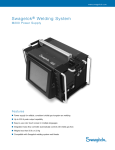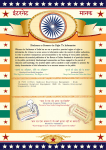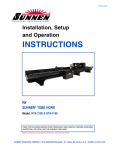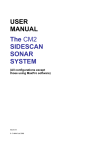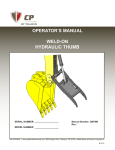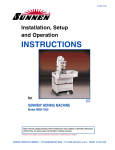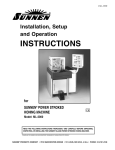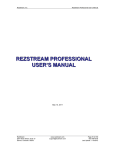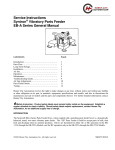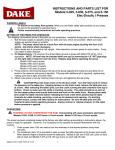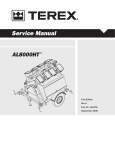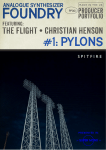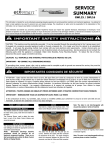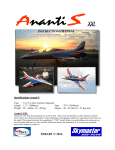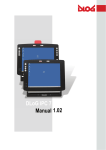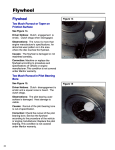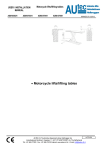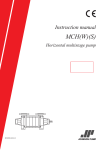Download DAWSON - Auksjonen.no
Transcript
DAWSON CONSTRUCTION PLANT LIMITED HPH 2400 HYDRAULIC HAMMER AND POWER PACK - USER'S MANUAL HAMMER SERIAL NO: .............................................. HAMMER COMMISSION DATE: ............................. POWER PACK SERIAL NO: ...................................... POWER PACK COMMISSION DATE: ...................... ENGINE TYPE: ........................................................... ENGINE SERIAL NO: ................................................ POWER PACK TYPE: ................................................. V6 23/05/07 CONTENTS 0.0 EC Declaration of Conformity 1.0 Introduction 1.1 5.0 5.1 2.0 5.2 5.3 How does the Hammer Work? 5.4 5.5 Power Pack and Hammer Operation 3.1 3.2 3.3 Connecting the hydraulic hoses and control pendant Checking the power pack Starting the power pack 3.3.1 3.4 Hydraulic oil warm-up procedure 3.4.3 3.4.4 3.4.5 Installing hammer on the pile Bleeding air from the hammer hydraulic system Pile driving with the hammer Cold running/overtravel Refusal 6.5 6.6 6.7 6.8 6.9 Figure 2 Using the hammer underwater Wider or special pile sections 7.0 7.1 7.2 7.3 7.4 7.5 Preventive Maintenance Guideline Chart Hammer Maintenance 4.1 Daily maintenance 4.2 Planned 125 hour maintenance checks Figure 4.1 4.3 Planned 250 hour maintenance checks 4.3.1 4.3.2 4.4 Changing Disc Springs Other items Planned 500 hour maintenance checks Figure 5 4.5 Power pack engine will not start Engine cuts out during running Power pack does not generate any pressure Power pack generates pressure but hammer does not run Hammer will lift but not drop Hammer runs erratically Excessive hose 'jumping' Hammer 'jumping' excessively on pile top Stroke height indicator will not move Hammer parts list Accumulator parts list and instructions See Cummins service manual Power pack parts list 7.4.1 7.4.2 7.4.3 Figure 4 4.0 Maintenance procedures Setting procedures Appendices Figure 3 3.7 Planned 1000 hour maintenance checks Every 125 hours Every 250 hours Every 500 hours Every 1000 hours Troubleshooting 6.1 6.2 6.3 6.4 Using the hammer 3.4.1 3.4.2 3.5 3.6 6.0 Basic specification Lubrication specification Daily maintenance checks Planned maintenance checks 5.3.1 5.3.2 5.3.3 5.3.4 Transportation and laying hammer down Figure 1 3.0 Power pack specifications 5.1.1 5.1.2 Basic Safety Points - Basic Specification of HPH 2400 - Drawing - Lifting the HPH 2400 & Power Pack Drawing 1.2 Power Pack Maintenance Hydraulic circuit schematic Electrical circuit schematic General assembly drawing Tool kit parts list DAWSON The responsible person:DAWSON CONSTRUCTION PLANT LIMITED CHESNEY WOLD, BLEAK HALL MILTON KEYNES MK6 1NE ENGLAND EC DECLARATION OF CONFORMITY Description: ___________________________________ Type: ___________________________________ Serial Number: ___________________________________ The above mentioned equipment conforms to the Machinery Directive 89/392/EEC(a) as amended by Council Directive 91/368/EEC(b), Council Directive 93/44/EEC(c) and Article 6 of Council Directive 93/68/EEC(d). Signed for and on behalf of Dawson Construction Plant Limited: ............................................................................. Name: ............................................................................. Position: ............................................................................. Date: ............./............./............. 1.0 INTRODUCTION The D.C.P. Hydraulic Hammer has been designed and manufactured to meet the demands of today's contractor. The hammer has many advantages over traditional piling hammers, including other hydraulic hammers:- The hammer fits all British and most foreign single sheet piles as well as numerous 'H' piles using one set of legs and inserts. It will also fit pairs of sheet piles and open bent corners with the same configuration. This significantly improves productivity and reduces costs. - The hammer does not have a single electrical component on it. This means no vulnerable electrical cable running across the site and no delicate electronics on the hammer. All competent fitters can understand this hammer. - Hydraulic hammers are inherently efficient, typically 80-90% of the potential driving energy being transferred into the pile as opposed to 25-35% for diesel hammers. - Rapid blow rate. The hammer is double acting, not only giving high energy output, but increasing the speed of operation. This inevitably increases production and keeps the pile on the move. - Infinitely variable stroke controlled, between limits, at the touch of a button. This enables precise energy control which is very important when commencing piling or when coping with delicate operations. - Robust construction. The hammer has been designed with full knowledge of what is required of piling equipment. A quick look at the hammer sitting on a pile will confirm this. - With the hammer weighing only 6 tonnes, it lends itself to being used on long reach jobs where there are few economic alternatives. - Noise levels are considerably lower than that of diesel or air hammers. - Transmitted ground vibrations have been measured lower than that of a vibrator. 1.1 Basic Safety Points - Ear protection should be worn when in close proximity of the hammer. - Keep clear of the hammer and/or power pack when they are being lifted. - Avoid standing directly below the hammer when it is piling. - Adhere to maintenance requirements set out in this manual. - Lift equipment using lifting points specified only (see figures over). 1.2 Transportation and laying down hammer - BEFORE operating hammer first time AND after each lay-down use inspection holes to ensure dolly is seated correctly in anvil before striking. - WHEN LAYING DOWN HAMMER, support top of hammer at higher level than bottom of hammer. - TRANSPORTATION, support top of hammer at higher level than bottom of hammer. 2.0 HOW DOES THE HAMMER WORK? (See fig. 1) The D.C.P. Hydraulic Hammer consists of a 'drop weight' driven up and down by a 'hydraulic ram' inside a 'casing.' The hydraulic ram is double acting which means the drop weight is accelerated both on the upstroke and on the downstroke. This gives the hammer its very efficient energy output and high blow rate. The oil supplied to the hydraulic ram comes from the power pack via a 'control valve' mounted inside the top of the hammer. This control valve switches the oil supply on or off at the upstroke side of the hydraulic ram i.e. oil supply 'on' lifts the drop weight and oil supply 'off' drops it. The control valve itself has to be switched from one position to another at precisely the right times for optimum performance. The control valve is switched by hydraulic pilot signals from two mechanically actuated sensors mounted on the hammer casing. The 'bottom sensor,' when actuated by the drop weight, switches the control valve to the on (lift) position and the 'top sensor' switches the control valve to the off (drop) position. The stroke of the drop weight is adjusted by moving the position of the top sensor e.g. moving the sensor down reduces the stroke or vice versa. The position of the top sensor is altered by a small 'height adjusting ram' mounted inside the top of the hammer. This is adjusted as required by the operator who can view an indicator on the side of the hammer. The hammer is fully controlled using a hand-held control pendant. This unit enables the hammer to be started/stopped, run on single/automatic blows and have its stroke varied. The controller may be used from a remote position. 3.0 POWER PACK AND HAMMER OPERATION 3.1 Connecting the hydraulic hoses and control pendant (The power pack must be turned off at this time to enable correct installation of the hoses) There are four hydraulic hoses running between the power pack and the hammer, viz: 1. Pressure line (1¼" BSP) carries the main high pressure oil supply to the hammer. 2. Return line (1½" BSP) returns low pressure oil from the hammer to the power pack. 3.} Height adjusting lines (3/8" BSP) used to deliver 4.} Oil to the height adjusting ram, as required. The pressure/return hoses have the same specification. However, the return hose ends have larger fittings than the pressure hose to avoid possible confusion. Similarly, the height adjusting hoses have different end types. The hoses should be left connected to the hammer at all times - this reduces the likelihood of oil contamination and reduces leakage problems. The hoses should be connected/ disconnected at the outlets of the power pack. All these connectors are of the 'quick-release' type. The hoses should be disconnected from the power pack when moving the power pack around to avoid straining the connectors. Make sure that the connectors are thoroughly cleaned when making a connection Having connected the hoses, next fit the hand control pendant connector block to the multi-pin outlet from the power pack. This is positioned below the instrumentation panel of the unit. Check that a clean connection is made and that no water is present in either half of the connection. The 'power' switch on the controller should be turned off. 3.2 Checking the power pack before starting Having connected the hydraulic hoses and hand control pendant, as described in section 3.1, next check fluid levels on the power pack. Check: a. engine oil level b. diesel fuel level c. hydraulic oil level, and fill if required Notes:1. The diesel fuel and hydraulic oil tanks have sight gauges on the side of the tanks. 2. The power pack will not run if the hydraulic oil level is too low. 3. The hammer will not run if the hydraulic oil temperature is too low. The auto warm-up routine must be used to pre-warm the oil. See section 3.3.1. 3.3 Starting the power pack (see fig. 2) Prior to starting the power pack, check that the hand control pendant is turned 'off.' Set the throttle control lever to half of full throttle (2). Turn 'on' the battery isolator (1). Push the engine start push button (4) until the engine starts. Allow the engine to reach working temperature by running it at 1500 r.p.m. under zero load for 10-15 minutes. Check all gauges and diagnostic lights for correct function of unit (diagnostic lights should be off.) Notes:1. If any of the following L.E.D.'s (7, 8, 9 and 10) are 'on' when the isolator switch (1) is turned 'on,' the power pack will not start. Rectify problem immediately. 2. If L.E.D. (11) is on, the power pack will start but the pendant will be ‘dead’ until the hydraulic oil warm up procedure is carried out. 3.3.1 Hydraulic Oil Warm-up Procedure If the hydraulic oil temperature is less than +25ºC, L.E.D. (11) will be on and the oil will require warming prior to using the hammer. The hand control pendant will be ‘dead’ for as long as L.E.D. (11) is on. To warm the oil:a) Run the engine at 1800 r.p.m. b) Turn the ‘warm-up/run’ selector switch (5) to ‘warm-up’. (The engine should go under load and the high pressure gauge (13) should read approx. 200 bar). c) Leave the pack in this condition until the L.E.D. (11) goes off. (The engine should come off load at the same time the L.E.D. goes out and gauge (13) return to zero bar). d) Turn the ‘warm-up/run’ selector switch (5) to ‘run’. The power pack is now ready for use. 3.4 Using the hammer 3.4.1 Installing hammer on the pile The hammer must be sat correctly on the pile to avoid hammer or pile damage. The pile tops should be as level and square cut as possible. The hammer anvil must be in good condition. Lift the hammer onto the pile(s) to be driven. Lower the hammer down until the handling slings lose their tension. At this point, the anvil should be seated correctly i.e. the rubber ring around the anvil should be compressed between the casing and the anvil. If it is not and there is a gap here, re-site the hammer. Note: Before using the hammer (and particularly after transportation) check that the dolly is fitted correctly in the anvil. There are inspection holes at the bottom of the hammer casing to check this. 3.4.2. Bleeding air from the hammer hydraulic system - only required when running hammer after initial connection or following a repair When running the hammer for the first time after initial connection to the power pack, there will be air in the hydraulic system. The hammer will 'bleed' this air automatically but the following procedure must be applied:a. Run the power pack at 2200 r.p.m. b. Turn on the control pendant 'power' button. c. Adjust the stroke height indicator to minimum using the '↓' push button. d. Set the 'Auto/Man' turn button to 'Man.' e. Hold the 'start' push button down for 2-3 seconds. f. Repeat (e) three or four times until the hammer consistently gives one or two small blows each time. Providing the hammer does not 'jump' on the pile, hold the 'start' push button down, so that the hammer gives several consistent blows, on the next operation. (Approximately 120 blows per minute.) If the hammer 'jumps' on the pile, because the drop weight is hitting the top of the hammer casing, the hammer will stop automatically. To reset see section 3.4.4. g. Commence the piling operation using the hammer as required. 3.4.3 Pile driving with the hammer Having the hammer sited on the pile and removed air from the hydraulic system (if necessary) as described above, the hammer is ready for pile driving:a. Increase the power pack engine speed to 2200 r.p.m. (having followed - "Starting the power pack" section 3.3) b. Turn the hand control pendant 'power' button on. c. Adjust the 'stroke height indicator' on the side of the hammer to minimum stroke by pressing the '↓' push button. d. Set the 'Auto/Man' selector button to the required position: 'Auto' - hammer will continue running automatically when the 'start' push button is pressed once. 'Man' - hammer will only run whilst the 'start' push button is held down. e. Depress the 'start' push button as required by 'Auto/Man.' f. During operation the hammer stroke may be altered using the '↑' or '↓' push buttons to adjust the stroke height indicator. g. To stop the hammer whilst it is running on 'Auto,' turn the 'Auto/Man' selector to 'Man' or turn the 'power' selector off. It is good practice to start piling with the hammer set on minimum stroke, this limits unnecessary damage to both the hammer and the pile when the pile can be driven easily. The stroke may then be adjusted to suit the changing driving resistance. On certain piling jobs, it may be possible to start driving on pairs of sheet piles, changing over onto a single sheet pile as the driving resistance increases (this will give maximum productivity.) 3.4.4 Cold running/overtravel The hammer 'jumps' on the pile top when trying to achieve full stroke if the hydraulic system is 'cold.' If this happens, the hammer will stop automatically. (Thus preventing internal damage to the unit.) The power pack will continue to run and the 'pressure' gauge will read approximately 240 bar. In order to reset the hammer, turn off the 'power' selector on the hand control pendant and stop the power pack. Allow the engine to stop for approximately 10 seconds then restart the unit. Reduce the stroke of the hammer to minimum. Run the hammer at this lower setting until the oil is warm enough to allow correct full stroke setting. If reducing the stroke does not cure the problem, warm the hydraulic oil as described in section 3.3.1. If the hammer overtravels again, refer to the Troubleshooting section 6.0. THE HAMMER WILL NOT RUN IF IT IS NOT ALLOWED TO RESET CORRECTLY 3.4.5 Refusal Piling must stop with this hammer when the rate of driving reaches 10 blows per 25mm. Continued use will result in hammer and/or pile damage Revision Qnt. BATTERY ISOLATOR Date Intro. Appr.by OIL HOT OIL COLD OIL LOW FAST IDLE ENGINE START MANUAL AUTO LOWER START RAISE PENDANT PANEL WARM UP RUN ENGINE STOP FLOW 2400 4500 NOTES:THIS DRAWING MUST NOT BE REPRODUCED BY ANY MEANS WITHOUT PRIOR PERMISSION OF THE COPYRIGHT OWNER. Ref.no. Design by RJC Qnt. Drawn by RJC Part name Copied - Checked Material - Standard A4 Affirmed - Remark Dimension Scale - Replace File - Drawing no. Replaced by - Date 15/04/2005 3.5 Using the hammer underwater It is possible to drive piles with this hammer underwater. However, the hammer must be prepared correctly in order to do so - it can not be used underwater in standard format. The work involved is briefly as follows:a) The stroke adjuster ‘slot’ in the leg guide must be sealed with a cover. b) The insides of the hammer should be suitably greased to minimise the effects of corrosion. c) The gaps between hammer casing, leg guides and top cover must be sealed with silicone mastic. d) The inspection holes near the bottom of the hammer casing must be plugged. e) A threaded compressed airline port must be added in the bottom end of the hammer casing or leg guide. f) The hammer must be run in conjunction with a 35/70 c.f.m. (100 psi) air compressor. g) The hammer grease nipples must be greased after every pile drive to ensure ample lubrication. NOTE: FOR DETAILED ASSISTANCE WITH THIS TYPE OF WORK PLEASE CONTACT THE MANUFACTURER. 3.6 Wider or special pile sections. The HPH 2400 hammer in standard format will drive a considerable range of steel piles. In some applications, however, where sheet piles are particularly wide or perhaps boxed together it is possible to use simple leg insert modifications and/or spreader plates to give improved pile coverage reducing pile head stress and improving productivity rates. The standard leg inserts can have “wing extensions” bolted on to correctly centralise the hammer on a single sheet pile. Then either a special anvil can be used to give wider coverage, or, by dropping the inserts to a lower set of location holes, a ‘spreader plate’ can be added below the standard anvil to give improved pile coverage. This is a tried and tested technique (see figure 3). With tubular piles, for example, the standard inserts can be removed and in place some simple bolt on plates added to centralise the hammer on the tube (see figure 4). A further refinement, if necessary, is to weld a ring onto the underside of the anvil to give correct location on the tube. PLEASE CONTACT THE MANUFACTURER IF YOU HAVE A SPECIFIC PILE DRIVING PROBLEM - IT MAY HAVE BEEN DONE BEFORE! 3.7 PREVENTATIVE MAINTENANCE GUIDELINES FOR HPH 1200 & 2400 HYDRAULIC HAMMERS, AND DIESEL ENGINED POWER PACKS DAILY OR REFUELLING EVERY 125 HOURS CHECK: • OIL LEVEL • COOLANT LEVEL • FAN - INSPECTION • DRIVE BELT - INSPECT • FUEL WATER TRAP - DRAIN CHECK: • HYDRAULIC OIL LEVEL • AIR INLET/OUTLETS FREE FROM OBSTRUCTION • CONDITION OF LIFTING POINTS & SLINGS/SHACKLES • TEST DIAGNOSTIC LEDS • INSPECT GAUGES • CONDITION OF QUICK RELEASE COUPLINGS CHECK • ALL EXTERNAL FASTENERS FOR TIGHTNESS • DOLLY CONDITION • SUSPENSION BLOCK & SUSPENSION RING CONDITION • LIFTING POINT CONDITION • SERVICEABILITY OF SLINGS/SHACKLES CHECK: • AIR CLEANER • INTAKE SYSTEM • CHARGE AIR COOLER CHECK: • FOR HYDRAULIC OIL LEAKS & RECTIFY • CONDITION OF HOSES • TIGHTNESS OF FASTENERS • CONDITION OF PAINTWORK • BATTERY WATER LEVEL • FUNCTION OF PENDANT & CONDITION OF CABLE CHECK: • BATTERY CHARGING CHECK: • TIGHTNESS OF ALL HOSES, FITTINGS AND FASTENERS INSIDE HAMMER • CONDITION OF BOTH SENSORS • WEAR LEVEL ON LEG INSERTS CHECK: • ACCUMULATOR NITROGEN PRECHARGE PRESSURES • HAMMER FILTER • FUNCTION OF OVERTRAVEL VALVE • FUNCTION/CONDITION OF PROBE ASSEMBLY AND BOTTOM TRIP DEVICE CHANGE: • HYDRAULIC OIL/FUEL FILLER FILTERS CHANGE: • RESILIENT WASHERS BETWEEN DROP WEIGHT & HYDRAULIC RAM ON HPH 2400 ONLY MUST: • GREASE HAMMER FREQUENTLY - EVERY 250 HOURS CHANGE: • LUBE OIL • LUBE FILTER TEST RUN ON PILE 15 MINUTES BEFORE AND AFTER CHECKING TEST RUN ON PILE 15 MINUTES BEFORE AND AFTER CHECKING EVERY 500 HOURS EVERY 1000 HOURS EVERY 2000 HOURS CHANGE: • FUEL FILTER ADJUST: • VALVE LASH CLEARANCE CHANGE: • ANTI FREEZE CHECK: • ANTI FREEZE CHECK: • FAN HUB • BELT TENSIONER BEARING • BELT TENSION CHECK: • DAMPER CHECK: • PRESSURE OUTPUT OF PUMP • FLOW OUTPUT OF PUMP CHECK: • CONDITION OF WIRING • DRIVE COUPLING FOR WEAR • CONDITION OF EXHAUST CHANGE: • PRESSURE/RETURN HYDRAULIC FILTERS CHECK: • CONDITION OF HEIGHT ADJUSTING RAM • TIGHTNESS OF ACCUMULATORS • CONDITION OF MAIN FEED HOSES TO HAMMER CHANGE: • HYDRAULIC OIL AND CLEAN OUT SYSTEM CHECK: • PLAY IN MAIN RAM ANCHORAGE ASSEMBLY • CONDITION OF ANVIL • PLAY BETWEEN DROP WEIGHT AND CASING BORE CHANGE: • RESILIENT WASHERS BETWEEN DROP WEIGHT AND HYDRAULIC RAM TEST RUN ON PILE 30 INUTES BEFORE AND AFTER CHECKING TEST RUN ON PILE 30 MINUTES BEFORE AND AFTER CHECKING (FOR FULL DETAILS SEE SECTIONS 4 AND 5 IN THE HAMMER MANUAL AND THE CUMMINS SERVICE MANUAL) TEST RUN ON PILE 30 MINUTES BEFORE AND AFTER CHECKING 4.0 HAMMER MAINTENANCE (SEE APPENDIX 7.1) 4.1 Daily maintenance checks (or every 10 hours) a. Apply Lithium based general purpose grease to hammer through each one of five grease points (part 1-057-00-01). Twenty operations of a grease gun on each grease point every shift will be adequate. b. Check all external fasteners for tightness and re-tighten where necessary. c. Check that the dolly (part 2-006-00-06) has not been damaged or worn beyond its serviceable limit. If the dolly is replaced, ensure that the O' ring is replaced with it (part 2-067-00-01). To inspect the dolly, remove sixteen screws (part 2-034-00-01) and drop the leg inserts (2-019-00-01 and 2-020-00-01) down far enough to view the dolly. If the dolly is compressed past it's serviceable limit or if the dolly is cracked in many places replace it. Please refer to figure 4.1 for guidance on acceptable dolly wear. To replace the dolly insert a steel bar through one of the holes in the bottom of the anvil (part 2-005-00-01) and drive the old dolly out using a hammer. Insert a new dolly (complete with O' ring) ensuring that it is pushed fully home. d. Check the suspension blocks (part 2-025-00-01) and suspension ring (part 2-024-00-5) for wear/damage and replace if necessary. These must be in good condition at all times. These items act as the hammers 'suspension system' reducing the shock transmitted from the blow to the hammer and its components - very important for keeping the hammer functioning correctly. e. Check the condition of lifting tackle and lifting points prior to being taken into service. 4.2 Planned 125 hour maintenance checks (run the hammer for 15 minutes before and after this maintenance work) Every 125 hours the following work should be carried out in addition to that described in 4.1 above:a. Remove each hammer leg guide in turn and check the condition and tightness of: all hydraulic hoses and fittings; bolts; locking rings, and visually check all components for condition. b. Check the condition of each sensor assembly paying particular attention to cam wear, roller operated valve travel and tightness of fixing bolts. Each roller valve should have a travel of 4mm through full actuation of its associated cam. This measurement is critical and if it is not achieved the hammer will not run correctly (as with the ignition timing on a motor car). Travel can be lost through excessive cam wear or with wear on the roller or roller pin at the end of the valve. c. Check the condition of leg inserts to ensure correct fitting on pile sections. The inner faces of each insert should touch the opposite insert. If not, the wear faces may require building up with hard facing. Figure 4.1 Debris embedded in dolly, remove debris and continue. Severely cracked 6500 dolly should be replaced. Overworked 6500 dolly stuck in anvil body must be replaced or it can cause the anvil body to break. If dolly is not replaced when it has been overworked, the anvil body can break due to expansion of dolly material. 4500 dolly starting to show signs of cracks after 150 hrs of piling. O.K. but if cracks extend to the outer edge or the underside of the dolly, it must be changed. View showing underside of 4500 dolly after 150 hrs of work. No signs of cracking. O.K. 4.3 Planned 250 hour maintenance checks (run the hammer for 15 minutes before and after this maintenance work) Every 250 hours the following work should be carried out in addition to the work described in 4.1 and 4.2 above: 4.3.1 Change the Disc Springs The flexible coupling between the main hydraulic ram and the drop weight must be changed. The procedure is quite straightforward (see figure 5). Failure to do this will result in an expensive repair. a. Lay the hammer on stable level ground on its Front Leg Guide packed on timbers. Remove the Rear Leg Guide (part 2-002-00-01). b. Remove the 3 no. Nyloc Nuts, Dog Point Grub Screws and Anti-Vibration Washers (parts 6945, 2-088-00-01 and 2-089-00-01) from the Connector Nut (part 2-011-00-03). It may require a little heat to melt the Loctite on the grub screws. c. Unscrew the Connector Nut from the Ram Connector (part 2-009-00-04) and remove the Nut together with the top stack of Disc Springs (2-022-00-01), Guide Bush (2-015-00-02) and Buffer Spacer (2-012-00-04). d. Retract the piston rod of the Hydraulic Ram from the Drop Weight by hand and remove the other Disc Spring stack. e. Inspect the removed steel components for wear and replace those with signs of fretting or bruising. Dispose of the old Disc Springs if there are any signs of radial cracking or unusual wear - do not reuse them if in doubt. f. Ensure the Connector Nut threads are clean and fully degreased. Pay particular attention to degreasing the Grub Screws threads and the Grub Screws as this will ensure the Loctite adhesive works correctly. Failure to do this correctly may result in the assembly working loose! g. Re-assemble the connection as in figure 5 ensuring the new Disc Springs are installed in pairs using adequate EP Moly grease. Coat the Guide Bushes and Washers with EP Moly grease on all contact faces. Tighten the Connector Nut until it is hand tight, approximately 45 Nm (33ft.lbs). Tighten the Connector Nut further using a socket until the top Buffer Spacer is compressed by 2.5mm. Align a Dog Point Grub Screw hole in the Connector Nut with one of the axial slots in the Ram Connector thread. This may require the Nut to be tightened slightly further. h. Install the 3 no. Dog Point Grub Screws using some Loctite 270 Studlock thread adhesive, and fully tighten each in turn to the torque quoted on Figure 5. Next install the pairs of antivibration washers onto each grub screw and lock the grub screws using new Nyloc nuts. i. Re-assembly the Rear Leg Guide on the hammer. The unit is now ready for running. 4.3.2 Other items a. Check the accumulator (part 1-048-00-04) precharge pressures using the gas pressure checking kit and a bottle of nitrogen gas. The precharge pressures are:High pressure -100 bar (two accumulators) Low pressure - 3 bar (two accumulators) To gain access to the accumulators it is necessary to remove the top cover (part 2-017-00-01). The two high pressure accumulators are on the left hand side viewed from the inlet manifold. To check the precharge pressures see appendix 7.2 in this manual. b. Check the hammer filter (part 2-079-00-01) for cleanliness. First remove the top cover (part 2-017-00-01). Then unscrew the filter bowl and remove the filter element. Check the filter for damage and any unusual debris. Wash the filter with clean diesel and blast through from inside the filter with compressed air. Alternatively throw the element away if it is a non-metallic filter. PAY EXTRA CARE NOT TO ALLOW DIRT INTO THE FILTER ASSEMBLY ON RE-FITTING c. Check the function and condition of the bottom trip device. d. Check the function of the hammer’s overtravel valve by intentionally overstroking the hammer when cold. 4.4 Planned 500 hour maintenance checks (run the hammer for 30 minutes before and after this maintenance work) Besides work mentioned in 4.1, 4.2 and 4.3 above the following work should be carried out:a. Condition and function of the Height Adjusting Ram. b. Tightness of the Accumulator assemblies. c. Condition of the main feed hoses between the hammer and power pack. Hoses with excessive amount of “braiding” exposed or damaged should be replaced. 4.5 Planned 1000 hour maintenance checks (run the hammer for 30 minutes before and after this maintenance work Check the following:a. Play in the main ram anchorage assembly. b. Condition of the Anvil. c. Play between the Drop Weight and Casing bore. Note: It is strongly recommeded that in order to achieve thorough and correct maintenance of this equipment that customer’s service personnel should be fully trained by the manufacturer. 5.0 POWER PACK MAINTENANCE 5.1 Power pack specification 5.1.1 Basic specification Engine power output Engine maximum r.p.m. Hydraulic flow output Max hydraulic pressure output Dimensions (l x w x h) Weight - 66 kW @ 2300 rpm 2300 150 l/min 230 Bar 1900 x 1400 x 1800mm 2000 kg - Fina Hydran LZ 32 or equivalent 465 litres 15 W 40 9.5 litres (incl. filter) DIN 51601-DK 235 litres 5.1.2 Lubrication specification Hydraulic oil type Hydraulic oil capacity Diesel engine oil type Diesel engine oil capacity Diesel fuel type Diesel fuel capacity 5.2 Daily maintenance checks (for full details of diesel engine maintenance see Cummins service manual) a. Check hydraulic oil level - must be visible in sight glass, but not over half way in sight. b. Check diesel lubrication oil level. c. Ensure pump isolator valve is fully open. d. Ensure air inlet/outlet panels are free from obstruction. e. Drain water from diesel water trap. f. Inspect lifting tackle and lifting points before being put into service. g. Check function of diagnostic L.E.D.’s by pressing test button. h. Check function of gauges. i. Check condition of quick release couplings. j. Check engine coolant level. k. Check condition of fan and drive belt. 5.3 Planned maintenance checks For full details of diesel engine maintenance see Cummins service manual and for power pack maintenance procedures see section 5.4. 5.3.1 Every 125 hours Check the following:a. Hoses, pipework and fittings for any hydraulic oil leaks and rectify as required. b. Tightness of all fasteners. c. Condition of body panels and paintwork. Touch-up where necessary. d. Battery water level. e. Condition and function of hand control pendant. 5.3.2 Every 250 hours Check the following:a. Engine air cleaner. b. Engine intake system c. Engine charge air cooler. d. Battery charging rate. Change the following:e. Engine oil. f. Engine oil filter. g. Hydrauic oil filling filter. h. Diesel fuel filling filter. 5.3.3 Every 500 hours Check the following:a. Anti freeze in engine coolant. b. Pump output flow rate and working pressure. Change the following:c. Fuel filter. d. Hydraulic oil pressure and return filters. 5.3.4 Every 1000 hours Check the following:a. Engine fan hub. b. Engine belt tensioner bearing. c. Engine belt tension. d. Adjust valve lash clearance on engine. e. Condition of all wiring and tightness of electrical connectors. f. Wear on hydraulic pump flexible coupling. g. Condition of exhaust. Change the following:h. System hydraulic fluid. 5.4 Maintenance procedures NOTE: Before any of the following procedures are undertaken, the battery isolator switch must be switched off. a. Changing fuel/hydraulic oil inlet filler elements. (i) (ii) (iii) (iv) (v) (vi) (vii) Replacement element Remove filter bowl Remove and discard filter element (do not clean) Wash bowl thoroughly Fit replacement element into bowl Re-assemble filter Prime hand pump b. Changing hydraulic pressure filter element. (i) (ii) (iii) (iv) (v) (vi) (vii) (viii) Replacement element Remove filter bowl Remove and discard filter element (do not clean) Wash bowl thoroughly Fit replacement element onto spigot Fill filter bowl with clean hydraulic oil Replace bowl O' ring if necessary Re-assemble filter c. Change hydraulic return filter element. (i) (ii) (iii) (iv) (v) (vi) (vii) (viii) Replacement element Remove filter bowl Remove and discard filter element (do not clean) Wash bowl thoroughly Fit replacement element onto spigot Fill filter bowl with clean hydraulic oil Replace bowl O' ring if necessary Re-assemble filter d. Pump removal/re-fitting. (i) IMPORTANT NOTE (ii) (iii) (iv) (v) (vi) (vii) (viii) - the hydraulic pump should be returned to the manufacturer for repair/overhaul. This item must not be stripped or tampered with. Isolate pump from hydraulic oil reservoir using pump isolator valve Remove hoses from pump body Remove mounting screws from front flange of pump Withdraw pump from coupling towards oil reservoir Remove bellhousing from engine mounting flange Reverse procedure for re-assembly Fill case drain of pump with clean hydraulic oil prior to start up following removal from the system (port located on the top of the pump with adaptor fitted) e. Cooler removal/re-fitting. (i) (ii) (iii) (iv) Close pump isolator valve to prevent system syphoning Remove flexible hoses from cooler Remove mounting bolts from cooler To remove matrix, remove top and bottom retaining strips from front of cooler and withdraw matrix from front of cooler assembly f. Control valve assembly. (i) Close pump isolator valve to prevent system syphoning (ii) To replace solenoid coils remove plastic retainer from end of coil and withdraw coil from retaining tube (iii) To replace valve assemblies remove 4 off retaining screws from top of valve and replace component as necessary g. Pipework. (i) For details of hose assemblies see hydraulic schematic drawing Appendix 7.4.1 (ii) In the event of steel pipe failure, 25mm 3 series fittings should be utilised in conjunction with 25mm bore x 3mm wall thickness tube (iii) Welded pipe ends are currently utilised and should it become necessary to disturb these fittings a replacement O' ring should be used h. Changing system hydraulic fluid (i) (ii) (iii) (iv) (v) (vi) (vii) (viii) (ix) (x) Change hydraulic fluid Remove cleanout cover and clean reservoir Replace fuel inlet and hydraulic fluid inlet filter elements Replace hydraulic pressure line filter element Replace hydraulic return line filter element Blow through cooler matrix to clear Replace solid pipe fitting O' rings as necessary Replace tank cover gasket Check all electrical connections for tightness Check drive coupling for wear and replace or adjust if necessary 5.5 Setting procedures a. Re-setting pressure The pressure regulating adjuster is situated on the main control valve assembly. To adjust: (i) (ii) (iii) (iv) Loosen the lock nut and wind the centre spigot counter clockwise to reduce pressure Press the test button on the control panel to load the system Turn the centre spigot clockwise to raise the system pressure When the required pressure has been achieved (max 230 bar) tighten the lock nut NOTE: Should the required pressure be exceeded, wind the adjuster back and increase again. Never wind the pressure downwards to set b. Engine gauges replacement. (i) There is a resistor fitted to all gauge power lines. This must be replaced after maintenance to prevent damage to the gauges. 6.0 TROUBLESHOOTING 6.1 Power pack engine will not start a. Check battery condition. b. Check diagnostics panel for fault LED showing (see fig. 2.) 6.2. Engine cuts out during running a. Check diagnostics panel for fault LED showing and rectify (see fig. 2.) 6.3. Power pack does not generate any pressure a. Check L.E.D. (11) to see if hydraulic oil is up to temperature (see figure 2). If not perform warm-up operation described in section 3.3.1. b. Check operation of main valve in power pack by turning selector switch (5) to ‘warm-up’ on the instrumentation panel (fig. 2.) This gives 200 bar reading on pressure gauge. c. Check fuses or electrical connections to valve block if no reading from (b). d. Check operation of relief valve if no reading from (b). e. Check operation of hand control pendant and fuses in electrical box if reading is O.K. in (b). 6.4. Power pack generates pressure but hammer does not run a. Anvil not pushed fully up into hammer casing (see section 3.4.1.) or the dolly is not sitting correctly in the anvil (especially after transportation or laying on its side) b. Air in hammer hydraulic system - see section 3.4.2. c. Hammer has been allowed to overtravel - see section 3.4.4. to reset. d. Damaged hose on control side of hammer - check by removing front leg guide for inspection. e. Faulty bottom sensor assembly - lay the hammer on timber blocks on level stable ground on its rear leg guide then remove front leg guide and check bottom sensor as follows:(i) Cam/spring operation - does the cam rotate/return freely and is the spring in good order. (ii) Check for correct lift on valve roller (4mm) (iii) Check 'trip' arrangement for correct function (part 2-083-00-04 & 1-036-00-05) (iv) It is possible to work the hammer for diagnostic purposes whilst it is laying on the ground. However, extreme caution must be exercised when doing so as incorrect operation will cause hammer damage. Always ensure the pendant is in MANUAL mode and NOT automatic mode. The anvil must be in the ‘up’ position so as to ensure the trip device is ‘off’. The hammer can be pressurised by ‘tapping’ the ‘start’ push button on the pendant (power pack running) very gradually building up enough pressure to move the drop weight. If the button is held for too long the drop weight will possibly impact the inside top of the hammer - not a good idea! However, by careful application of this method it is possible to check pressure is reaching the relevant sensor. If it is not, then the problem may be with the overtravel valve (part 1-084-00-02) not allowing oil flow to the control side of the hammer. This can be confirmed by removing the main pressure feed to either sensor - no oil flow when pressurising the system indicates overtravel valve problems and this item should be removed for inspection. (The overtravel valve can be removed through the wide slot in the side of the hammer encased by the rear leg guide and the hammer will require turning over to do this). Turn the power pack off before removal. When checking the overtravel valve first check the small restrictor/dowel on its top face for any blockage. The valve is unlikely to be faulty inside and if this is suspected the unit should be returned to the manufacturer for checking. If pressure is reaching the sensor check that the pilot signal from the sensor is reaching the main control valve block at the top of the hammer when the roller valve is operated. If not, remove and inspect the roller valve. f. If this all appears to be in order check the top sensor mechanism in a similar manner to that described in e. (i) and (ii) above as it may be that the top sensor is jammed on. Note: The spool inside the roller valve and the roller shaft are not connected so even though the roller returns when operated it does not follow that the spool has returned. Check the tension on the roller shaft, if there is none the spool may be stuck open. g. If all appears well the problem may be with the main control valve spool. Contact the manufacturer for further details. 6.5 Hammer will lift but not drop a. Has the hammer been allowed to overtravel. Check reset - see section 3.4.4. b. Air in hammer hydraulic system - see section 3.4.2. c. Damaged 'looped' hose from sensor assembly - check by removing front leg guide for inspection. d. Faulty top sensor assembly - see 6.4.e. as diagnosis is similar to faulty bottom sensor assembly. e. Faulty bottom sensor assembly i.e. valve is staying on (see section 6.4.f. for similar diagnosis) 6.6 Hammer runs erratically a. Air in hydraulic system - see section 3.4.2. b. 'Cold' hydraulic oil - see section 3.4.4. c. Accumulator pressures incorrect or bladders damaged. See Appendix 7.2.High pressure accumulator Low pressure accumulator - 100 bar 3 bar (2 off) (2 off) d. Blocked filter on hammer - see section 4.2.b. e. Not enough hydraulic flow/pressure from power pack - check flow rate gauge and pressure gauge. f. One or both sensors damaged/contaminated - see sections 6.4 and 6.5, 6.7 Excessive hose 'jumping' Check accumulator pressures/condition - see Appendix 7.2. 6.8 Hammer 'jumping' excessively on pile top - reduce stroke immediately and/or stop piling a. Too much hydraulic oil input - set to 150 l/min. b. 'Cold' hydraulic oil - see section 3.4.4 and reduce stroke. To warm the oil see section 3.3.1. c. Stroke adjuster set too high - reduce immediately to continue working. d. Suspension blocks (2-025-00-01) and ring (2-025-00-05) damaged. Inspect and replace immediately, if necessary. e. Incorrect operation of top sensor assembly i.e. cam wear and/or incorrect roller travel. 6.9 Stroke height indicator will not move a. With the power pack running and control pendant connected, check pressure gauges when '↑' and '↓' are pressed. If no readings, check relevant valve and wiring/fuses in power pack. b. If readings are O.K., check hoses to hammer. If these are O.K., check restrictor orifices for blockages - these are the male/male adaptors located on the inlet manifold c. If these are clear remove front leg guide and check height adjusting ram (2-026-00-01) and top sensor assembly. APPENDIX 7.1 HPH 2400 HYDRAULIC HAMMER PARTS LIST HYDRAULIC HOSE DETAILS FOR HPH 2400 Control Side of Hammer (Sensor Side) - Assembly Number 2.110.00.01 Qty Description (Hose Length = Cut Length) Part No. 2 off Hose Assy 965mm 3/8" R2T c/w 20 x 1.5 heavy 12s fem E/E 2.110.01.01 4 off Hose Assy 990mm 3/8" R2T c/w 20 x 1.5 heavy 12s fem E/E 2.110.02.01 4 off Hose Assy 750mm 3/8" R2T c/w 20 x 1.5 heavy 12s fem E/E 2.110.03.01 3 off Hose Assy 920mm 3/8" R2T c/w 20 x 1.5 heavy 12s fem E/E 2.110.05.01 3 off Hose Assy 1160mm 3/8" R2T c/w 20 x 1.5 heavy 12s fem E/E 2.110.06.01 30 off GE12 PSR ED 12s x 3/8" BSP Stud 1.111.14.02 2 off RHZ 12 PSR ED 12s x 3/8" BSP Stud (check valve) 1.100.03.02 Height Adjusting Ram Hoses 1 off Hose Assy 560mm ¼" R2T c/w 16 x 1.5 heavy 8s fem to 8s 45° fem 2.110.08.02 1 off Hose Assy 530mm ¼" R2T c/w 16 x 1.5 heavy 8s fem to 8s 45° fem 2.110.08.03 2 off GE8 PSR ED 8s x ¼" BSP Stud 1.111.12.01 2 off GE8 PSR ED 8s x 3/8" BSP Stud 1.110.02.02 Power Side of Hammer (Supply Side) - Assy Number 2.111.00.05 Hose Assy 2480mm (Flange to Flange) 1½" R13 c/w 1½" SAE 6000 Straight Flange - Interlock type 2.111.01.01 1 off Hose Guard c/w Cable Ties 2.111.04.01 1 off Hose Assy 1500mm (Flange to Cone) 1" 4SH c/w 42 x 2 heavy 30s fem to 1" SAE 6000 Straight Flange - Interlock type 2.111.02.01 1 off Voss Flanged Elbow 195241 1.111.17.01 4 off 1½" SAE 6000 Split Flange Clamps - metric bolt holes 1.088.00.01 2 off 1" SAE 6000 Split Flange Clamps - metric bolt holes 1.111.20.01 8 off M16 x 55 Socket Head Cap Screws 4056 8 off M16 Spring Washer 1.090.00.01 4 off M12 x 45 Socket head Cap Screws 1.111.24.01 4 off M12 Spring Washer 1.094.00.01 1 off Fittings for underside of Inlet Manifold 2 off 3/8" BSP M/M Adaptor (restricted 0.79mm bore) 1.100.02.02 1 off 1¼" BSP M/M Adaptor 1.101.08.01 1 off 1½" BSP M/M Adaptor 2.111.03.01 Appendix 7.2 – Accumulator Parts List and Instructions Appendix 7.2 – Accumulator Parts List and Instructions Important Safety Notes for Bladder Accumulators 1. Use nitrogen gas only 2. All accumulators are supplied precharged to 100bar (1450 psi) unless sent via air-freight – in which case they will be shipped unprecharged 3. Always use the gas filling apparatus supplied by Dawson. This equipment includes a regulator valve specifically designed for use with hammer accumulators where the precharge pressure is less than the supply cylinder pressure. 4. Read the instructions below fully before attempting to adjust the precharge in any accumulator 5. Routine maintenance on the accumulator in-situ or removal of the accumulator must only be carried out when the hydraulic system pressure has been completely removed. Accumulator Pre-charge Pressure High pressure accumulator – 100 bar Pre-charge Procedure Low Pressure Accumulator – 3 bar Figure 1 1. Remove Protective Cap (1) and Sealing cap (2) – see figure 1. 2. Attach the Regulator Valve to the nitrogen cylinder – see figure 2. 3. Attach the charging set (5) to the accumulator gas valve assembly (6) and connect charging hose (7) between the regulator and the charging set connection. 4. Back off handle (8) anticlockwise until loose. Check gas bleed valve (9) on charging set is closed and screw hand wheel (10) clockwise to open gas valve. 5. Open nitrogen cylinder valve by turning key (11), cylinder pressure will register on right hand gauge (12). This pressure should be checked against the required precharge pressure. 6. Turn handle (8) clockwise until outlet pressure on left hand gauge (13) registers 10% higher than required precharge pressure (110 bar or 3.5 bar). When pressure on the charging set and outlet gauges are equal, close nitrogen cylinder valve. 7. Turn hand wheel (10) anticlockwise to seal gas valve. 8. Crack bleed valve (9) to exhaust gas from charging hose and remove hose from charging set and replace hose connection sealing cap. 9. Close bleed valve, turn hand wheel (10) clockwise to open gas valve and crack bleed valve (9) to vent down to required precharge pressure. Close bleed valve. 10. Turn hand wheel (10) anticlockwise to reseal gas valve, crack bleed valve and remove charging set from the accumulator. 11. Test accumulator gas valve for leaks using soapy water or similar. 12. Replace sealing cap (2) and tighten with pliers. Replace protective cap using a wrench. Inspection and repair of Accumulators Due to the nature of the design and specific assembly procedures it is recommended that the accumulators should only be inspected and repaired by a competent person. Dawson Construction Plant Limited or their approved dealers will be happy to undertake this work as required. Please note the Important Safety Notes at the beginning of this section. Removal of Accumulator Pre-charge • Remove Protective Cap (Item 6) from the Bladder Stem by unscrewing anti-clockwise • Remove the Sealing Cap from the Gas Valve Assembly (Item 4) • Connect Charging Set to the Gas Valve Assembly • Release all the gas pressure by opening the Bleed Valve (Item 9 on the gas Charging Set) • Disconnect the Charging Set from the Accumulator Removal of Accumulator Lid & Bladder • Remove M16 Socket Head Cap Screw (Item 13) and washers (Item 14) • Remove Lid & Bladder (Item 2) from Accumulator Housing (Item 1) Cleaning and Inspection • Clean all metallic components with an organic solvent – do not use on rubber components • Inspect the Bladder (Item 3) for any visible signs of damage. (Cracking or Surface Abrasion etc.) • Inspect the Housing (Item 1) and Lid (Item 2) both inside and outside for signs of corrosion / mechanical damage. • Replace any parts found or considered to be defective. • Replace the following parts irrespective of condition: 1) O-Rings – items 7, 8,10, 11 and 12 2) Back -up Ring – item 9 • If the unit was removed from the system the connecting O-Rings (items 11 and 12) should be replaced irrespective of condition Replacement of Bladder – having removed the Accumulator Lid • Unscrew the Gas Valve Assembly (Item 4) from the Bladder Stem by turning anti-clockwise. • Remove the Locknut (Item 5) from the Bladder Stem by turning the Locknut anti-clockwise, remove the bladder from the Accumulator Lid. Fitting of Bladder to Lid • Ensure ‘O’-Ring (Item 8) is fitted to new the Bladder’s stem. Push the stem through the central hole in the Lid (Item 2) then fit Locknut (Item 5) Fitting of Bladder & Lid to Accumulator Body • Checking that all O-Rings & Back-up Rings are in Place. Expel all nitrogen from the Bladder (Item 2) to enable it to pass through the top opening in the Housing (Item 1). • Insert the assembled Bladder & Lid into the Accumulator Housing aligning the holes in the Lid with the M16 tapped holes in the Housing • Ensure the M16 Socket Head Cap Screws (Items 13) are in good clean condition then install them together with the M16 Nordlock washers (Items 14) into the top of the Housing • Tighten Items 13 to a torque of 231Nm (173 lbs.ft) • Re-fit the Gas Valve Assembly (Item 4) and tighten • Re-fit the Protective Cap (Item 6) and tighten Re-Assembly is now complete and the accumulator is ready to be Pre-charged – see details at the top of this section. PRIOR TO APPLYING HYDRAULIC PRESSURE TO THE SYSTEM THE ACCUMULATOR MUST BE PRECHARGED WITH NITROGEN IN ACCORDANCE WITH THE ABOVE INSTRUCTIONS. FAILURE TO DO SO WILL RESULT IN BLADDER FAILURE. APPENDIX 7.4 HPH 2400 POWER PACK PARTS LISTS – please refer to Power pack manual for full details APPENDIX 7.5 HYDRAULIC HAMMER TOOL KIT (PART NO. 2.150.00.01) PART NO. QTY. 065 1 off 3mm Allen Key 066 1 off 4mm Allen Key 067 1 off 5mm Allen Key 068 1 off 6mm Allen Key DESCRIPTION 2.150.01.01 1 off 8mm Allen Key 2.150.02.01 1 off 12mm Allen Key 2.150.03.01 1 off 14mm Allen Key 070 17mm Allen Key 1 off 1.150.02.01 1 off 19mm Allen Key - long series 1.150.03.01 1 off 22mm Allen Key 2.150.04.01 1 off 10mm Combination Spanner 1.150.12.01 1 off 19mm Combination Spanner 1.150.27.01 1 off 22mm Combination Spanner 1.150.28.01 1 off 24mm Combination Spanner 1.150.29.01 1 off 27mm Combination Spanner 1.150.09.01 1 off 18” Adjustable Spanner 1.150.21.01 1 off External/Internal Circlip Pliers 1.150.20.01 1 off 5/16" Parallel Pin Punch 1.150.24.01 1 off Soft Hammer 1.150.18.01 2 off M24 Lifting Eye 1.150.16.01 1 off ¾” Sliding T Bar 1.150.23.01 1 off ¾” 200m Extension 2.150.06.01 1 off 65mm Socket 1” Square Drive 2.150.07.01 1 off ¾” Fem to 1” Male Convertor 2.150.05.01 1 off 2¼” A/F Open End Spanner 1.150.25.01 1 off Grease Gun 1.070.00.01 1 off Gas Filling Apparatus



















































